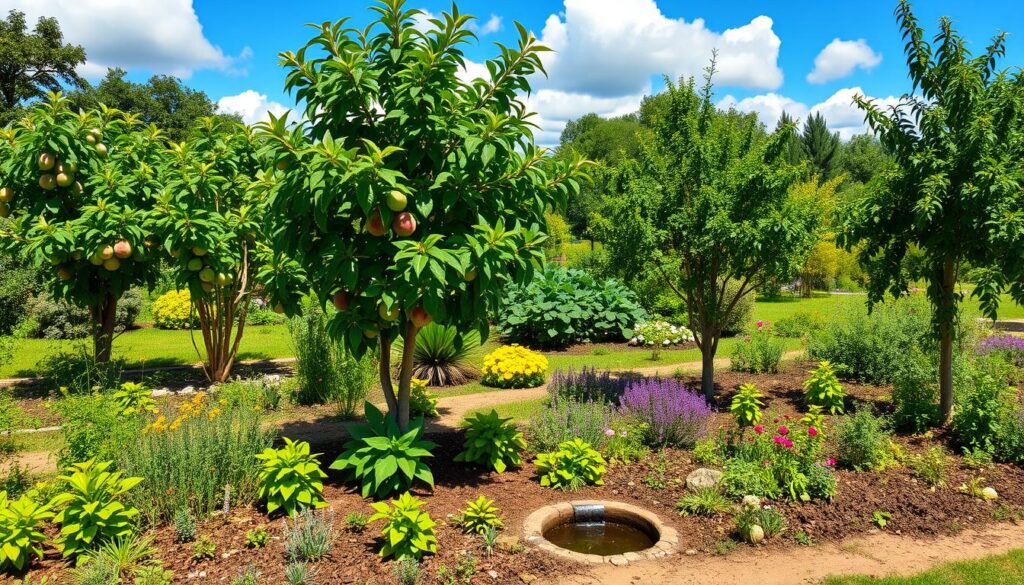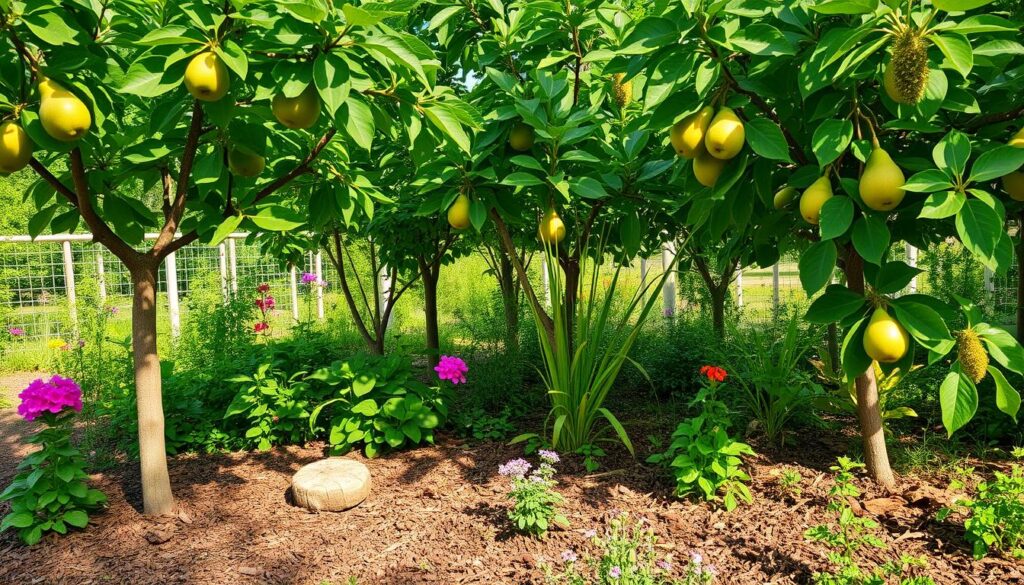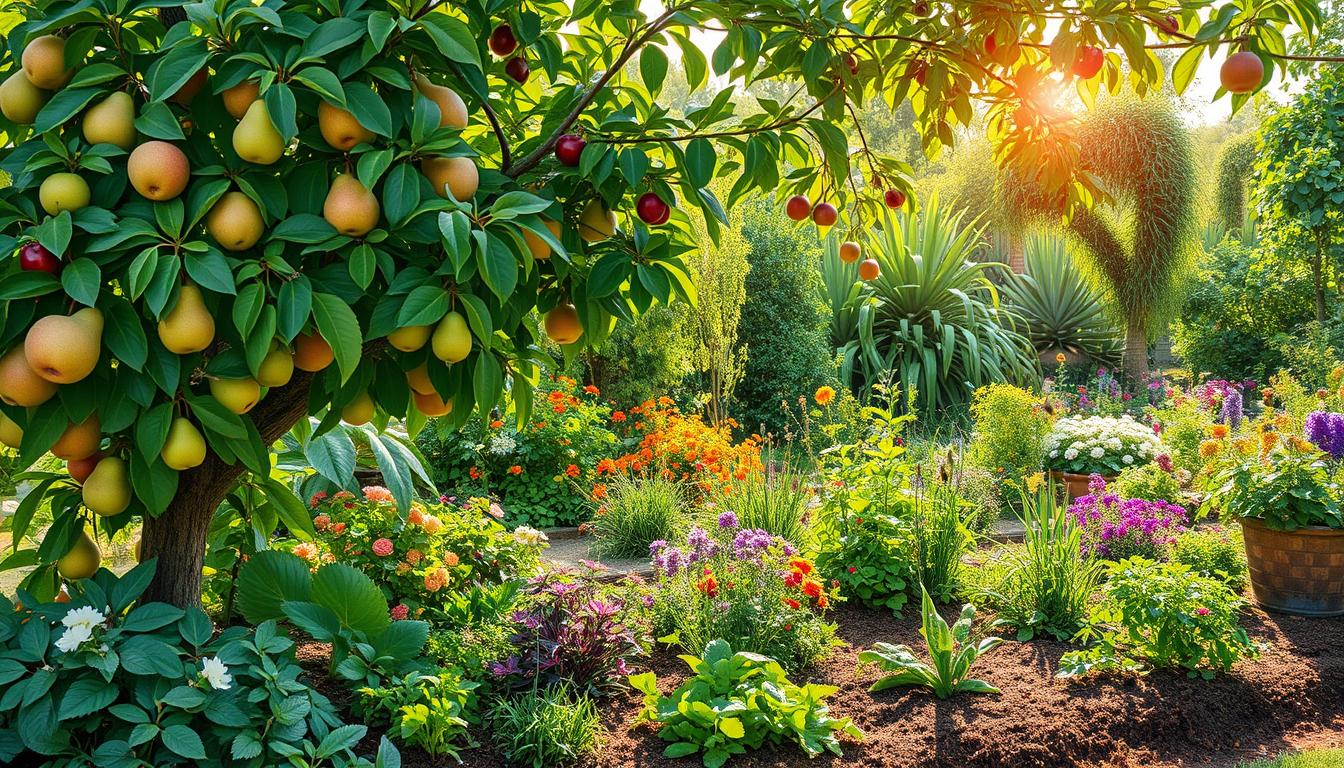Building a fruit tree guild is key to sustainable gardening. It uses permaculture’s principles. By mixing different plants, I make a lively ecosystem that uses land well and boosts biodiversity. My garden’s fruits are not just food; they also make my garden beautiful and useful.
I aim to create a guild that helps my fruit trees grow. It also supports other plants and helpful insects. This way, my garden grows well and stays healthy, following my eco-friendly gardening goals.
Key Takeaways
- Fruit tree guilds enhance biodiversity in permaculture gardens.
- Creating a supportive ecosystem benefits both plants and insects.
- Edible landscaping combines beauty and utility for sustainable gardening.
- Harmonious plant partnerships can boost fruit tree productivity.
- Establishing a fruit tree guild aligns with eco-friendly gardening practices.
Understanding Permaculture and Its Benefits
Permaculture is a way of gardening that works with nature, not against it. It uses ecology and sustainability to make systems that are strong and productive. This leads to a deeper look at what permaculture is, its principles, and its many benefits.
Definition of Permaculture
Permaculture is a design that aims for sustainable and regenerative systems. It looks at nature and tries to copy its efficiency and diversity. Gardens made with permaculture methods work well with their environment, keeping things balanced.
Permaculture Principles
Knowing the permaculture principles is key to making it work. Some main principles are:
- Observe and Interact: Watching the natural world helps me make choices that help the whole ecosystem.
- Catch and Store Energy: Using renewable resources makes my gardening more sustainable.
- Diversity: Having more types of plants in my garden helps it fight pests and stay strong.
- Use and Value Renewable Resources: My gardening focuses on using things that can be renewed.
Benefits of Implementing Permaculture
Permaculture offers more than just pretty gardens. It brings:
- Improved Soil Health: Healthy soil means plants grow better, making food healthier.
- Reduced Labor: Permaculture gardens need less work once they’re set up.
- Increased Yields: As the garden grows, it becomes more productive and diverse.
- Resilience: Permaculture gardens adapt well to changes, supporting long-term health.
Using permaculture in my garden makes it more productive and helps the local ecosystem. These sustainable gardening practices lead to a stronger and more vibrant landscape.
What is a Fruit Tree Guild?
The fruit tree guild is a key part of permaculture. It’s a group of plants around a fruit tree. Each plant helps the garden grow better.
Definition and Components of a Fruit Tree Guild
The fruit tree guild definition includes many plants. These are climbing plants, shrubs, and ground covers. The main components of a fruit tree guild are:
- Climbing plants that add more food or shade
- Herbaceous plants that attract good bugs and fix nitrogen
- Ground covers that keep weeds away and hold moisture
- Medicinal plants with healing properties
- Edible plants that add to the fruit harvest
When making a guild, think about space and plant size. This ensures plants fit well together.
Advantages of Guild Planting
The advantages of guild planting are many. They help your garden thrive. Key benefits are:
- More biodiversity for a strong ecosystem
- Better nutrient use through plant interactions
- Less pests with companion plants
- More use of space in small gardens
These plants work together for a self-sustaining garden. This makes gardening easier and grows healthier plants. With plants like rosemary, echinacea, and strawberries, your garden will flourish. By following these principles, you’re working with nature, growing well, and succeeding in permaculture.
Learn more about building a fruit tree guild and improve your gardening today.
How to Create a Fruit Tree Guild for Permaculture Gardens
Creating a fruit tree guild in my permaculture garden is all about careful planning. It’s about understanding the garden’s ecosystem. By following a step-by-step guild planting method, each plant works well together. This guide will help you pick the right fruit trees and other plants for sustainable gardening.
Step-by-Step Guide to Guild Planting
Starting a fruit tree guild involves a few key steps:
- Selecting a Suitable Location: Check the area for sun and soil quality. These affect the trees’ growth.
- Choosing Complementary Plants: Add plants like nitrogen-fixers and pest repellents. They help create a balanced ecosystem.
- Maintaining the Guild: Keep an eye on all plants’ growth and health. Make changes as needed to boost productivity.

Choosing the Right Fruit Trees
When picking fruit trees, I look for diversity. Dwarf and self-fertile trees save space and pollinate well. They offer a variety of fruits all season long. Key things to think about include:
- Resistance to Local Pests: Pick trees that do well in my area and fight off pests.
- Growth Habit: Think about the tree’s size when it’s fully grown. This prevents overcrowding.
- Yield Timing: Choose trees that fruit at different times. This means you’ll have fruit to harvest all season.
With the right planning and plant choices, my guild thrives. It not only makes my garden better but also helps with biodiversity, pest control, and water use. This makes for a sustainable gardening experience.
Choosing Companion Plants for Your Guild
Choosing the right plants for my fruit tree guild is key to a healthy garden. Companion planting helps plants work together, offering many benefits. These include better pest control, soil health, and homes for good insects. This approach helps my garden grow strong and sustainable.
Benefits of Companion Planting
Companion planting brings many advantages. Some of the main benefits are:
- Natural pest control, reducing the need for harmful pesticides.
- Enhancement of soil fertility through nitrogen-fixing plants.
- Attraction of pollinators, ensuring more abundant fruit yield.
- Increased biodiversity, which contributes to a resilient garden ecosystem.
Recommended Companion Plants for Fruit Trees
To make a fruit tree guild successful, I can use a variety of plants. Some good choices are:
- Clover – A great nitrogen-fixer and ground cover that prevents weeds.
- Comfrey – Known for its deep roots, it accumulates nutrients and provides mulch when pruned.
- Nasturtiums – These flowers attract beneficial insects while deterring pests.
- Borage – A flowering herb that improves soil quality and attracts pollinators.
- Various herbs like rosemary and oregano, which help repel pests.
By carefully choosing fruit tree guilds companion plants, I can make my garden more productive and environmentally friendly. For more gardening tips, visit the contact page.
Designing Your Fruit Tree Guild
Creating a fruit tree guild is key to its success. Knowing about sun exposure and soil types is crucial. These factors help plants grow well together in a balanced ecosystem.
Considering Sun Exposure and Soil Type
I begin by checking the sunlight in my chosen spot. Sunlight is essential for fruit tree growth. I place taller trees on the north side to let shorter ones get more sun.
Soil quality is also vital. A soil test shows its pH and nutrients. This helps me pick plants that will do well in the soil. Adding plants like clover or peas helps the soil too.
Creating a Scaled Design Plan
Creating a detailed plan helps me see the guild’s layout. I use graph paper or software to map out plant spacing. This ensures plants have enough room and air.
I also use mulch basins and mounds in my design. They help with water and soil quality. Adding plants that keep pests away and attract beneficial insects is also important.
Designing a fruit tree guild needs a careful approach. By thinking about sun, soil, and planning, I create a thriving permaculture design. For more tips, check out privacy policies to make sure the info is up to date.
Implementing Your Guild: Steps to Take
Creating a fruit tree guild needs careful planning and detail. I start by gathering all the necessary materials for planting. This includes soil amendments, mulch, and tools. These items are key for a successful and sustainable garden.
Gathering Materials and Resources
Before planting, I check the following:
- Soil amendments: Compost, aged manure, and organic matter to improve the soil.
- Mulch materials: Straw, wood chips, or leaves to keep moisture in and weeds out.
- Tools: Shovels, trowels, and hand rakes for digging and planting.
I choose materials that support a variety of plants. This attracts beneficial bacteria, fungi, and insects. My goal is to create a balanced environment for healthy growth and pest control.
Planting Techniques for Success
Using the right planting techniques is crucial for a thriving guild. Here are some key methods:
- Proper planting depth: I make sure each plant is at the right depth for strong roots.
- Spacing: Plants need enough space to grow without competing for nutrients. I keep a 15-foot radius around each mature tree.
- Initial watering: I water thoroughly after planting. This settles the soil and helps new roots grow, essential for a sustainable garden.

By following these planting techniques, my fruit tree guild will flourish. This leads to more fruit and better water use. I’m proud to contribute to a vibrant ecosystem and enjoy the fruits of my labor.
Maintenance and Care for Your Fruit Tree Guild
Keeping a fruit tree guild healthy is key to its success. I focus on watering, fertilizing, and pruning to make sure it thrives. This way, my fruit trees and plants grow well together.
Watering and Fertilization Needs
Knowing how to water a fruit tree guild is vital. Plants with different roles help with watering, like stopping weeds and preventing soil loss. Mulcher plants, like comfrey, keep moisture in, reducing the need for frequent watering.
Adding nitrogen-fixing plants, such as silverberry and legumes, boosts soil fertility. Plants like artichoke and borage also help by adding minerals to the soil.
Pruning and Harvesting Practices
Pruning is crucial for a guild’s health and productivity. I remove dead or crowded branches to let trees get enough sunlight and air. This also helps with fruit production and keeps the landscape easy to manage.
When it’s time to harvest, I make sure my fruit trees and herbs are ready. This includes figs, peaches, and perennial herbs. By taking care of my guild, I get to enjoy the fruits of my labor for years to come.
Evaluating the Success of Your Guild
To check if your fruit tree guild is doing well, you need to use a few key methods. Regular checks help make your garden even better. I find it important to track how much fruit we get. This shows me how well the guild is working.
Watching how the plants in the guild are doing is also key. When plants are healthy, it means the guild is working right. I look for any signs of sickness or if they need more nutrients. Seeing beneficial insects around is a good sign too. They help keep pests away and pollinate the plants.
By doing these checks often, I learn a lot about what works in my garden. This knowledge helps me improve my garden and share with others. Sharing what we learn helps everyone make their gardens better.
| Evaluation Method | Description | Impact on Guild Success |
|---|---|---|
| Tracking Fruit Yields | Measure quantity and quality of produce harvested | Indicates plant compatibility and soil health |
| Observing Plant Health | Look for signs of diseases or deficiencies | Ensures timely interventions and plant care |
| Monitoring Beneficial Insects | Identify presence of pollinators and natural pest controllers | Enhances ecological balance within the guild |
Conclusion
Starting a fruit tree guild has been a journey full of learning and joy. By using permaculture principles, I’ve helped the environment and enjoyed great harvests. Plants like beans and comfrey have made my soil better and my garden more diverse.
This way of gardening supports many different plants and makes my garden strong. It’s become a place where my family and the planet both benefit. Adding plants like bee balm has made my apple trees more productive. It also shows how important sustainable gardening practices are to me.
Looking back, I’m excited to keep learning and trying new things. What I’ve learned reminds me of the value of living in harmony with nature. It leads to gardens that are not just productive but also good for our souls and the earth.



Leave a Reply